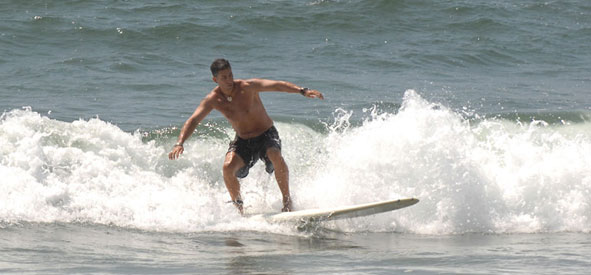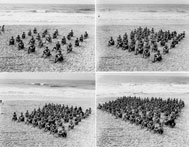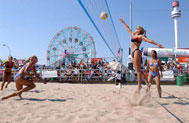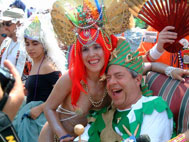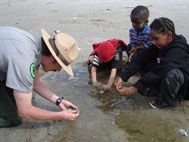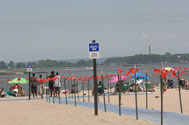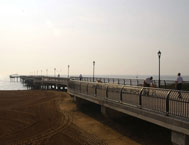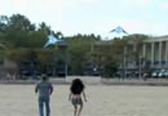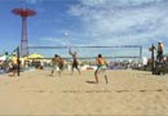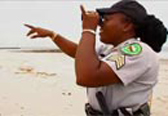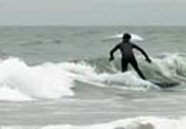History of Beach Life
Find information about NYC’s beaches, their hours, and locations at the Beaches webpage.
Lifeguards
Beach safety isn't only about cleaning the water and shorefront. Lifeguards are a necessity, and each year Parks staffs its beaches with nearly 1,200 lifeguards who watch over the busy city waters. Urban legend has it that during World War II, a Parks official, facing lifeguard shortages, circulated an internal memorandum asking whether trained dolphins might be recruited to fill the staffing gap.
During the era of Commissioner Moses, Parks developed a rigorous lifeguard training program that continues to this day. In 1969, the Parks Department waived height and weight requirements and recruited its first female lifeguards. To qualify for the training course, participants must be at least 16 years old, able to swim 50 yards in 35 seconds (a State Health requirement), and have a minimum vision of 20/30 in one eye and 20/40 in the other. The standards for beach lifeguards are even more stringent than those for pools. Finding enough qualified candidates being a persistent issue, in recent years the City has recruited hundreds of lifeguards from as far away as Eastern Europe to fill the 1,200 positions needed to keep the beaches safe.
Modern Sports
Beach volleyball has been a popular sport for many years, and today Parks hosts summer tournaments for players. And although it is associated with California, surfing also has an avid following in the East. In New York City, the best surfing action is at Rockaway.
In the late 1960s, surfers were at odds with local community leaders representing other beach users, and Parks Commissioner August Heckscher stepped in to mediate. In 1967, Heckscher designated three special surfing zones. After investigating claims that the surfers were unruly, he declared surfing to be a “legitimate and very beautiful sport, and commented that ” . . . it is apparent that the surfers are well-mannered persons and include among them a considerable number of charming youngsters. As of 2005, Rockaway Beach between Beach 87th to 92nd Streets became the first surfing only beach within New York City limits. A second spot between Beach 67th to 69th Streets was established in 2007.
Programs
Parks' Summer Fun in the Sun program features fireworks and sandcastle contests. Parks beaches have been the site of dance presentations, concerts, and even parades. The annual Mermaid Parade in June has established itself as a worthy addition to the bawdy traditions of Coney Island since its inception in 1983.
Shorefront Environmentalism
For as much use as a beach gets, it may come as a surprise that it is also a fragile environment. Beach erosion is a constant concern, and a fierce storm, such as the one New York experienced in February 1972, can devastate a shoreline. That storm limited access to the beach for several seasons thereafter.
In addition to erosion, storm damage, litter, public safety, and overcrowding, water quality is a constant concern, and is monitored by various City, State, and Federal environmental agencies, as well as the Health Department. Periodically, medical waste, oil spills, and run–off from storm sewers make a beach tempnorarily unsafe for swimming. In 1976, high levels of pollutants and sludge from local waste-treatment plants contaminated coastal waters, forcing the City and Long Island to shut down numerous beaches, which wreaked havoc on the tourist industry.
But thankfully, in recent years, the public and Parks have increased awareness about environmental concerns. For a number of years, beginning in the late 1990s, the Urban Park Rangers, in cooperation with the New York Aquarium for Wildlife Conservation (“Friends of Fishes” collective) and Pan Aqua Diving, organized a coastal ecology program at Coney Island near 8th Street. Descending beneath the water's surface with Scuba gear, they haul up and share with a hearty band of enthusiastic program participants a variety of spider crabs, blue-claw crabs, horse-shoe crabs, starfish, mussels, and other creatures, before releasing their catch back into their natural habitat, highlighting for children the active wildlife unseen below the water's surface.
And in recent years, Urban Park Rangers have participated in efforts to protect Piping Plovers that migrate to Rockaway each spring. As the endangered birds build their nests on the beach and gather food at the shoreline, their habitat is threatened by parkgoers. Yet the Urban Park Rangers have found a way to protect the birds while allowing for continued recreational use along the store-front an example of a modern day challenge.
Accessibility
Perhaps more significantly, Parks has reached out to disabled patrons to increase access to the waterfront. In 2007, Parks purchased “Mobi-Mats,” blue heavy-duty polyester mats that are positioned at access points along the boardwalk and anchored into the sand to provide a smooth level surface for wheelchairs. The mats made their debut at the Rockaways in Queens, on Orchard Beach in the Bronx, on Midland Beach in Staten Island, and at Brighton Beach in Brooklyn.
Recent Renovations
A renewed interest in New York City's 578 miles waterfront has resulted in several recent beach improvements. Over the past five years, Parks & Recreation has spent over $50 million on improvements to ´New York City's beaches, and there is an additional $10 million worth of ongoing improvements.
At Orchard Beach in the Bronx, $3.3 million was invested in 1998 to rebuild the monumental bathing pavilions and terraces. In addition, Orchard Beach's historic pavilion will undergo $6 million in renovations to stabilize the structure and reconstruct historical elements. At Midland Beach on Staten Island, an enormous capital investment has paid for boardwalk repair, a grand entrance plaza (2002), and a new fishing pier (2003). Also in Staten Island, a new beachfront greenway connects national park areas in Fort Wadsworth to South Beach and continuing south to Miller Field. Ocean Breeze Park, just across from South Beach, is slated for a large recreational facility as one of PlaNYC's major projects.
In 2004, the City opened a new oceanside skate park at Rockaway Beach in Queens, and the 2007 season saw a new accessible comfort station at 117th Street as well as the Flight 587 memorial at 116th Street. While Coney Island today measuring 2.7 miles from West 37th Street to Corbin Place with a boardwalk composed of 1.3 million boards held together by 15.6 million screws acquired new comfort stations, information kiosks, music pavilions, 95 newly replaced historic boardwalk lights, and KeySpan Park (2001), home to the Brooklyn Cyclones, visitors to Coney Island also have benefited from a $240 million renovation of the Stillwell Avenue subway terminal. The area will see additional changes once the proposed rezoning of the neighborhoods next to the beach is finalized, along with the implementation of the PlaNYC strategic plan for the iconic site. These amenities will ensure that the city's 12 million beach-goers continue to enjoy the city's beaches well into the 21st century.
